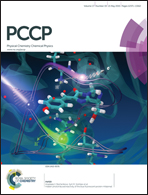Theoretical study of electronic and tribological properties of h-BNC2/graphene, h-BNC2/h-BN and h-BNC2/h-BNC2 bilayers†
Abstract
Density functional theory based methods are used to investigate the interlayer sliding energy landscape (ISEL), binding energy and interlayer spacing between h-BNC2/graphene (I), h-BNC2/h-BN (II) and h-BNC2/h-BNC2 (III) bilayer structures for three, six and fourteen different stacking patterns, respectively. Our results show that, in the studied cases, increasing the atomic variety of the ingredient monolayers leads to an ISEL corrugation increase as well. For the studied bilayers the ISEL is obtained by means of the registry index. For sufficiently large flakes of h-BNC2 on graphene sheets with the largest incommensurability and the least monolayer anisotropy, a robust superlubricity occurs regardless of the relative interlayer orientation. On the other hand, for the h-BNC2/h-BNC2 bilayer exhibiting the least incommensurability and the most monolayer anisotropy, the occurrence of robust superlubricity depends on the relative interlayer orientation.


 Please wait while we load your content...
Please wait while we load your content...